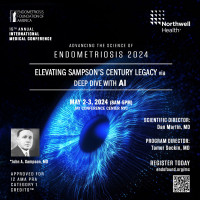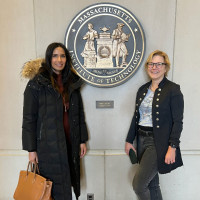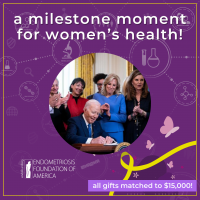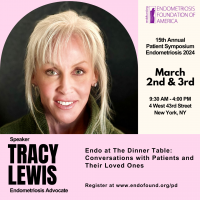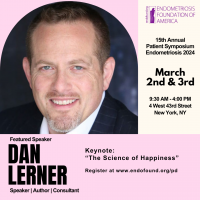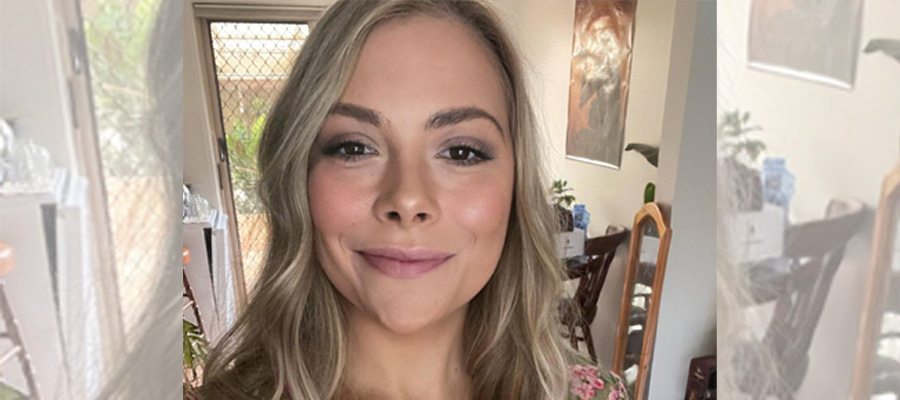
“What if people think I’m still pregnant?”
Those seven words cycle around my head while I frantically try on every pair of funky pants, floral skirt, and maxi dress I own. It’s my friend’s birthday celebration tonight. They aren’t really expecting me to turn up. Not after the week I’ve had. But life doesn’t stop, does it? A few espresso martinis and some much-needed laughs aren’t the worst way to begin moving forward. My bump hasn’t gone down yet. To be fair, it’s only been a few days. But damn, I wish my body worked quicker. Clearly, my ego and anxiety are thriving enough to convince me that every person at this pub will be staring at me, judging me, while I sip on my martini with a baby bump.
My baby was just that. My baby. His DNA ran through my veins. His presence made me sick 24/7 (they really need to stop calling it “morning” sickness). His body grew and my belly followed. He was a part of me, but now he’s gone.
I’ve suffered from endometriosis for years. I remember my first period like it was yesterday. I’ve always been better at remembering the negative experiences over the positive ones. Since 2016, I have had seven laparoscopic surgeries. Some were simple, others more complex. Some helped, others didn’t. My most recent surgery was in April this year. With every surgery, I would have an IUD removed and a new one inserted. This time, though, I walked out of there IUD-free.
My partner and I have always spoken about children. I think having a disease that focuses on the reproductive organs demands the conversation, at least for most. As one would expect, I was repeatedly told I would struggle to have a baby. In an ideal world, we may have wanted to wait longer. We could save more money first, travel a bit more, or just enjoy a life of less responsibility for a little bit longer. But we did not have the luxury of having time on our side. Plus, in the famous words of my very wise sister, “There’s always something you’ll want to do before having a baby, no matter how long you wait.” I look to her in many ways for guidance, especially in how she handles being a parent. Seeing her enjoy all the experiences life has to offer with her children made our decision to start trying earlier an easy one.
It had been seven weeks since my surgery when we found out I was pregnant. Only seven weeks. The shock of how quickly it happened was one that I never thought I would experience. We were over the moon but still outrageously nervous. It seems silly to say we were trying for a baby but were completely thrown off guard when we found out we had succeeded. Sadly, this was all very short-lived. Five days after we got our positive test, I had a miscarriage. We never even got to our dating scan. I’d like to describe how it felt, but there just aren’t enough words. We were devastated.
We were given many assumptions as to why this happened. My body still healing from surgery, chromosomal defects, or my uterine lining being too thin. The only explanation we could accept was, “Sometimes we just don’t know.” I know how common miscarriages can be for healthy-bodied people. I am not one of those people. So, we grieved, accepted our fate of this journey being harder than we thought, and tried to move on.
It would only take us four more months to become pregnant again. Funnily enough, we were just about to stop trying. During those four months, my pain was increasingly more difficult to manage. Without my trusty IUD, my periods and ovulation were unbearable. My OBGYN and I came up with an “action plan,” if you will: I would start taking Visanne the day of my next period. This pill essentially works like the contraceptive pill but had been researched specifically to help those who suffer from endometriosis. At least that’s what I was told. She also referred me to the hospital’s pain management team to look at receiving a ketamine infusion. The idea was we would get my pain under control, or at least manageable for a few months, and then start trying again. But my period never came.
I had a feeling I was pregnant before my missed period. All the symptoms felt so familiar. Sore boobs, a bigger appetite, could throw up on demand, and a little bit crampy. As most who are reading this would probably know, there’s usually no such thing as “a little bit crampy” in the endo world. It’s either zero or 100. We experienced the same shock we had before, all over again. Four months. That is all it took. Due to our miscarriage, this pregnancy was bound to come with a shadow of fear. But to not struggle with something that we were told for years would be something we would struggle with was amazing. We felt we had luck on our side for once.
Week eight came around and we heard our baby’s heartbeat. We saw their little arms and little legs waving around in there. We didn’t get this far last time. We told our nearest and dearest and started thinking of names. Every night I spent scrolling marketplace for good deals on baby essentials. I was taking the recommended amount of folic acid, had given up smoking (the moment we found out), was eating healthy, and resting when necessary.
My OBGYN said their little heart looked good, the placenta looked great, and my bloodwork checked out. Everything was going just as it should have been. The only hiccup was pain. As bubs grew, my “little cramping” became increasingly worse. We stacked this up to having seven surgeries worth of scar tissue surrounding bubs. My OBGYN prescribed me some pregnancy-safe pain relief and anti-nausea to allow me to manage day to day.
I had read varying accounts of endo sufferers during pregnancy. Some had nine months of relief and even decreased pain for years after giving birth. Some struggled the entire nine months and saw no relief or even increased pain afterward. I was beginning to suspect I would be in the second boat. But at the end of the day, I’m growing a baby! And with every week, I became closer to meeting them and closer to that hysterectomy I’ve always dreamt of having.
As with most pregnancies nowadays, you’re given the option to have genetic testing done at ten weeks and then again at 12 weeks. I had booked my appointment to receive the testing at ten weeks but had to reschedule it—there was no way I could drive the hour and fifteen minutes needed with the amount of pain I was in that day. So, week 12 came along, and off I went to get both the ten- and 12-week tests done. I was told this would just involve a blood test, but to my surprise, they do an ultrasound beforehand to confirm your date. I mean, any excuse to see bubs is a good one to me, so I was hyped!
The following hour is a bit of a blur. Something had shown up on the ultrasound. I had two sonographers come in. They were texting an OBGYN they knew, trying to get as many pictures as possible, swapping over and over from pelvic ultrasound to internal ultrasound while also swapping who was conducting the scan. When they were done, I was cleaned up and led into another room. I recall the heater was blasting in it, and I thought I would faint. They had set me up a Zoom call with their counsellor, who worked at another location. I was so confused and overwhelmed. I knew something was wrong with my baby, but I didn’t expect what would come next: “Your baby is not compatible with life.”
I had gone to this appointment alone as my partner had already taken time off work for the copious appointments we had and were going to have. I thought this would just be an in-and-out thing. Get a blood test and off I go. How could this happen? Is this a joke? Are they wrong? They’re wrong. They must be. A thousand questions and a thousand different conclusions than the one they just gave me ran through my head at once. Bubs has been fine. I’ve been fine. This can’t happen.
The following days were also one big blur. We had more scans and more appointments. It had been confirmed that bubs was suffering from some sort of spinal tube defect, apparently the worst one. You’ll have to forgive me for not knowing too much about it, but I haven’t brought myself to google it just yet. Our baby was really struggling. His heart was still beating, but it was already apparent that I would miscarry. Even if, somehow, I didn’t, he would not be born alive. We decided not to let our baby struggle any longer. So, within a few days, I was wheeled into an operating room. When I woke up, I was no longer pregnant.
“You didn’t cause this. You did everything right.”
Those words were said to me a hundred times by my OBGYN. Nevertheless, I still feel responsible. I don’t think that feeling will ever go away, even if it isn’t true. I was responsible for protecting my baby boy, and I couldn’t.
It’s easy enough to say that my endometriosis didn’t cause my two pregnancy losses. But we don’t know that. Was it the pain relief I was on? Did all those surgeries cause more harm than good? Has the endometriosis hindered something that we just can’t prove yet? I’m not sure I will get all the answers I so desperately want. It’s just another reason why we need to advocate for further research into the initial causes, pro-longed effects, and risks of endometriosis and its treatment.
Here’s to hoping our questions are answered sooner rather than later.
In memory of our Henry—we will always love you.
Editor's note: Would you like to contribute to EndoStories? Click here to learn how to submit your work.
*Patient stories submitted to EndoFound.org are the patient's views, not necessarily those of the foundation. All testimonials are from real patients, may not reflect the typical patient’s experience, and are not intended to represent or guarantee that anyone will achieve the same or similar results.





